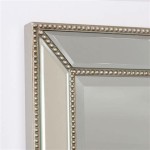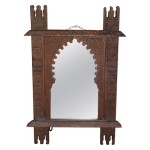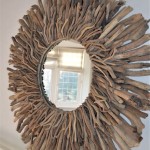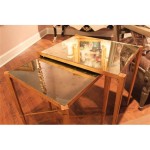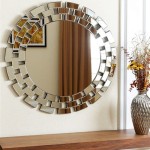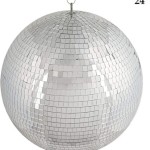How To Hang A Full Length Mirror On Wall
Hanging a full-length mirror can dramatically enhance a room, creating an illusion of spaciousness and providing a practical function. However, due to their size and weight, these mirrors require careful planning and execution to ensure secure and aesthetically pleasing placement.
Assess the Wall and Mirror
Before beginning, assess both the wall and the mirror. Identify the wall type (drywall, concrete, plaster) to choose the appropriate hanging hardware. Measure the mirror's dimensions and weight to select hardware with sufficient load-bearing capacity. Note any pre-installed hanging hardware on the mirror itself, as this will influence the installation method.
Choose the Right Hanging Hardware
Several hardware options are available for hanging heavy mirrors. Heavy-duty D-rings and wire are a common and reliable choice. J-hooks or French cleats provide a more secure alternative, distributing the weight evenly across the wall. For particularly heavy mirrors, consider using multiple hanging points for increased stability. For concrete or brick walls, specialized anchors will be necessary.
Locate and Mark Stud Locations
Locating wall studs is crucial for secure hanging, particularly with heavier mirrors. Studs offer the strongest support within the wall structure. Use a stud finder to identify their location and mark them lightly with a pencil. Ideally, the chosen hanging hardware should be anchored directly into these studs. If hitting a stud isn't feasible, use appropriate wall anchors rated for the mirror's weight.
Determine the Hanging Height
Consider the practical usage and aesthetic impact when determining the hanging height. Generally, the bottom edge of the mirror should be a few inches above the floor, allowing for easy viewing while preventing accidental damage. For mirrors used primarily for dressing, ensure the entire reflection is visible at a comfortable distance.
Pre-Drill Pilot Holes (If Necessary)
Depending on the wall type and chosen hardware, pre-drilling pilot holes can be necessary. This step prevents the wall from cracking or splitting, especially when working with harder materials like concrete or plaster. Ensure the drill bit size corresponds to the screws or anchors being used. For drywall, pilot holes smaller than the screw diameter are recommended to allow the screw threads to grip effectively.
Install the Hanging Hardware on the Mirror
If the mirror lacks pre-installed hardware, carefully attach D-rings, wire, or other chosen hardware according to the manufacturer's instructions. Ensure the hardware is evenly spaced and securely fastened to the mirror frame or backing. For D-rings, measure and mark their placement carefully to ensure level hanging. With wire, ensure adequate tension to support the mirror without being overly taut.
Mount the Hardware on the Wall
Using the marked stud locations or appropriate wall anchors, install the corresponding wall-mounted portion of the chosen hanging hardware. For D-rings and wire, install hooks or screws at the predetermined height, ensuring they are level. For J-hooks or French cleats, carefully mount the receiving portion on the wall, verifying its stability and alignment.
Hang the Mirror Securely
Carefully lift the mirror and engage the hanging hardware on both the mirror and the wall. For D-rings and wire, hang the wire on the hooks or screws. For J-hooks or French cleats, slide the mirror's corresponding hardware onto the wall-mounted portion. Ensure the mirror is securely seated and flush against the wall.
Check Stability and Alignment
Once the mirror is hung, thoroughly check its stability. Gently push on different areas to ensure it is firmly anchored. Visually inspect the alignment to ensure it is level and straight. Make any necessary adjustments to the hardware or hanging points to achieve optimal positioning. If using wire, adjust the tension as needed to ensure the mirror hangs straight.
Add Safety Measures (Optional)
For added security, especially in high-traffic areas or with particularly heavy mirrors, consider adding safety measures. Adhesive mirror backing can help secure the mirror to the wall, reducing the risk of it falling in the event of hardware failure. Earthquake straps can be used to further anchor the mirror to the wall, providing additional protection in earthquake-prone zones.

How To Hang A Heavy Full Length Leaner Mirror On The Wall House Of Hepworths

How To Hang A Heavy Full Length Leaner Mirror On The Wall House Of Hepworths

How To Hang A Heavy Full Length Leaner Mirror On The Wall House Of Hepworths

How To Hang A Heavy Full Length Leaner Mirror On The Wall House Of Hepworths

How High Should You Hang A Full Length Mirror

Where To Hang A Full Length Mirror Seriously Happy Homes Townhouse Designs Interior Foyer Design

How To Hang A Heavy Full Length Leaner Mirror On The Wall House Of Hepworths

Hanging Mirror Over The Door Neutypechic

51 Full Length Mirrors To Flatter Your Decor And Outfits

Large Full Length Mirror 150x50cm Black Metal Frame Dressing Wall Mounted Floor Standing Or Hang On The Door Rectangle Diy At B Q


